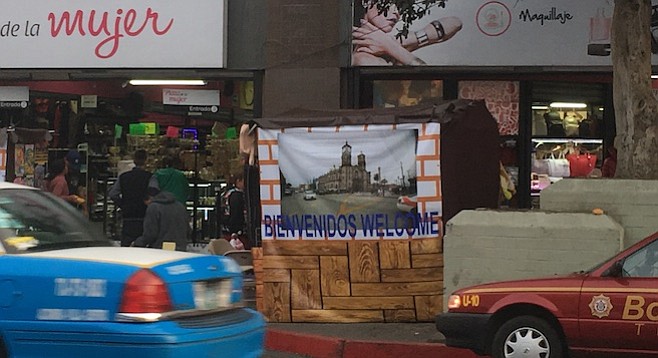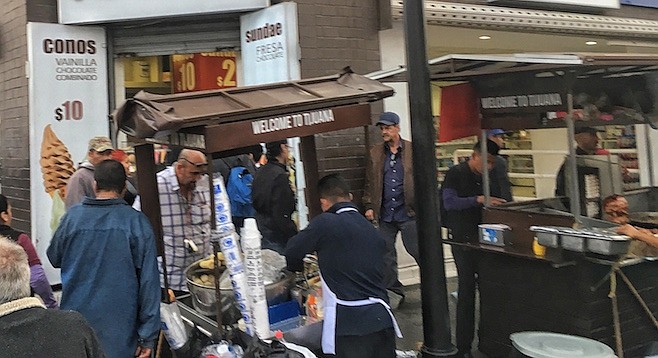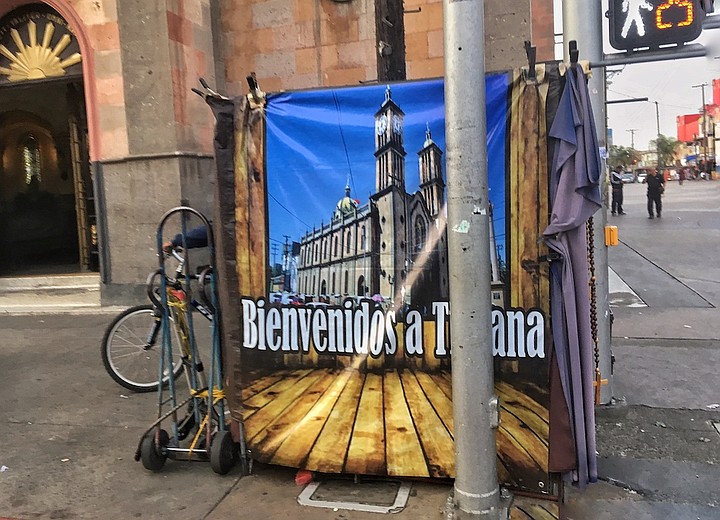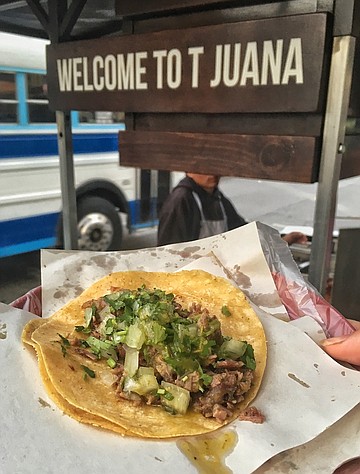 Facebook
Facebook
 X
X
 Instagram
Instagram
 TikTok
TikTok
 Youtube
Youtube

The trend to design exteriors of exposed brick and finished natural wood has made it to Tijuana. Many of the new and remodeled buildings have that modern look, clashing with the old sheet-metal carts of street vendors.

In mid-November, many vendors in Tijuana’s tourist areas covered their metal carts with wood finishes and “Welcome to Tijuana” written in white, brown tarps, and a small white sign with the emergency number 911 (Mexico switched the number in 2017). Tacos, churros, hot dogs y hamburguesas, elotes, tamales, fruit, and candy stands, and many other carts got the new look but still sell the same cheap food.
“We were forced to pay,” an old woman sitting at her candy stand on Calle Segunda told me. Her stand is across the street from Tijuana’s oldest cathedral. The stand went from improvised old tarps to new tarps with wood printed on them and “Bienvenidos/Welcome” with a picture of a Zonkey.
“It was the director of city hall. If they were free, great. But I had to pay 1300 pesos [roughly $70]. Taco vendors and other bigger carts had to pay way more. And if we didn’t, they were going to not let us work.”
I bought a couple of loose cigarettes that candy vendors usually keep hidden inside a box and moved on. (It’s illegal to sell individual cigarettes, though a very common practice).

A few steps away from the lady’s candy stand, a taco stand that used to be all sheet metal is now covered with wood. I got a couple of suadero tacos and tried to make casual conversation with the taquero.
“I don’t think they paid [for the remodel], I just came to work and the cart was covered with wood,” the young taquero told me. “I guess it looks nicer. I don’t think our customers care.”
After my tacos, I spotted an old man selling churros out of a traditional cart that was also redone with wood.
“I paid 6000 pesos [about $322] to cover my cart con maderita [with small pieces of wood],” the churro man told me as he handed me a paper bag with sugar-covered churros for 20 pesos. “I didn’t really have a choice, but it looks nice and I have nothing against it. I heard that nicer carts had to pay over 16,000 pesos [about $860],” said the old man, pointing across the street behind him.
Later that night, I went to get tacos in the direction the old man had pointed, from a busy vendor with a remodeled cart. “They wanted to charge us 12,000 pesos, but we did it ourselves,” the taquero assistant told me as I was paying for my two tacos de lengua. “It’s the same cart, we just covered it with wood and got a brown tarp. You will see. They will make all the vendors do the same thing.”

Not all street vendors have had to make the conversion; many may remain with the same sheet-metal look.
“They haven’t said anything to me,” said Israel Castillo, who runs a seafood street cart named El Buzo on Calle Segunda, a few blocks away from the remodeled vendors.
“Look, someone in the government, every time they switch administrations, they have different ideas. Years back they told us that all street vendors had to be sheet metal. Someone is going around with the idea that they all have to be wood now. I hope no one says anything, I’ve seen what they did with the carts y están bien gachos [they are really ugly].”


The trend to design exteriors of exposed brick and finished natural wood has made it to Tijuana. Many of the new and remodeled buildings have that modern look, clashing with the old sheet-metal carts of street vendors.

In mid-November, many vendors in Tijuana’s tourist areas covered their metal carts with wood finishes and “Welcome to Tijuana” written in white, brown tarps, and a small white sign with the emergency number 911 (Mexico switched the number in 2017). Tacos, churros, hot dogs y hamburguesas, elotes, tamales, fruit, and candy stands, and many other carts got the new look but still sell the same cheap food.
“We were forced to pay,” an old woman sitting at her candy stand on Calle Segunda told me. Her stand is across the street from Tijuana’s oldest cathedral. The stand went from improvised old tarps to new tarps with wood printed on them and “Bienvenidos/Welcome” with a picture of a Zonkey.
“It was the director of city hall. If they were free, great. But I had to pay 1300 pesos [roughly $70]. Taco vendors and other bigger carts had to pay way more. And if we didn’t, they were going to not let us work.”
I bought a couple of loose cigarettes that candy vendors usually keep hidden inside a box and moved on. (It’s illegal to sell individual cigarettes, though a very common practice).

A few steps away from the lady’s candy stand, a taco stand that used to be all sheet metal is now covered with wood. I got a couple of suadero tacos and tried to make casual conversation with the taquero.
“I don’t think they paid [for the remodel], I just came to work and the cart was covered with wood,” the young taquero told me. “I guess it looks nicer. I don’t think our customers care.”
After my tacos, I spotted an old man selling churros out of a traditional cart that was also redone with wood.
“I paid 6000 pesos [about $322] to cover my cart con maderita [with small pieces of wood],” the churro man told me as he handed me a paper bag with sugar-covered churros for 20 pesos. “I didn’t really have a choice, but it looks nice and I have nothing against it. I heard that nicer carts had to pay over 16,000 pesos [about $860],” said the old man, pointing across the street behind him.
Later that night, I went to get tacos in the direction the old man had pointed, from a busy vendor with a remodeled cart. “They wanted to charge us 12,000 pesos, but we did it ourselves,” the taquero assistant told me as I was paying for my two tacos de lengua. “It’s the same cart, we just covered it with wood and got a brown tarp. You will see. They will make all the vendors do the same thing.”

Not all street vendors have had to make the conversion; many may remain with the same sheet-metal look.
“They haven’t said anything to me,” said Israel Castillo, who runs a seafood street cart named El Buzo on Calle Segunda, a few blocks away from the remodeled vendors.
“Look, someone in the government, every time they switch administrations, they have different ideas. Years back they told us that all street vendors had to be sheet metal. Someone is going around with the idea that they all have to be wood now. I hope no one says anything, I’ve seen what they did with the carts y están bien gachos [they are really ugly].”
Comments